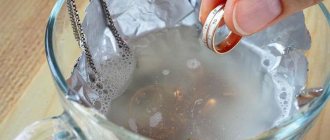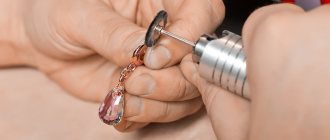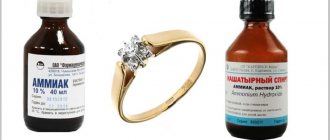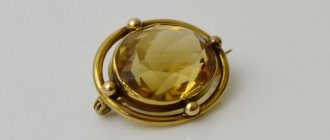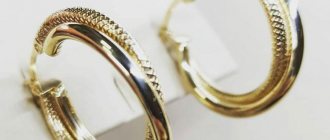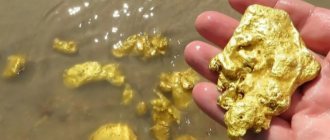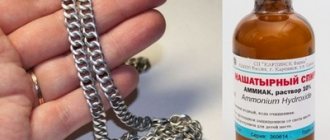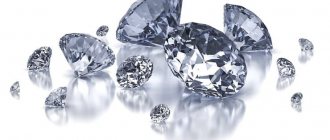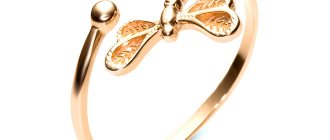All jewelry requires care, including gold jewelry. Even though gold does not oxidize in air, it can still become stained from time to time, as well as grease, dust and dirt. There are many ways to clean gold at home, and one of them is cleaning with ammonia. There are several recipes for cleaning gold with ammonia.
Naturally, you can always turn to professionals. But to do this, first of all, you will need to spend time finding a craftsman, bringing him the jewelry, and then picking it up. Not to mention that this will have to be done regularly and will require money. But there are ways to do it yourself.
Ammonia solution
First of all, you need to figure out what exactly the dirt that has formed on your jewelry consists of. Is it dust or are there metal oxides and other chemicals present? It depends on what method is needed to remove it; perhaps washing in a solution of water and soap will be enough, or it will be necessary to use more radical methods.
Oxides arise because other metals are usually added to gold: zinc, copper, silver, nickel and others. This is done in order to increase its characteristics such as hardness and wear resistance. Some of them can oxidize and interact with other substances, such as water, which leads to the formation of black and green spots on the surface of the jewelry.
The most effective cleaning will be one that occurs in three stages:
- pre-cleaning;
- chemical cleaning;
- mechanical cleaning.
Types and causes of gold contamination
Precious metals become tarnished through constant wear. The main problems include:
- external dirt, loss of shine;
- dark spots;
- scratches, deformation.
One of the advantages of gold is its resistance to oxidation. However, the softness of the metal does not allow it to be used in its pure form to create jewelry. To create a stable alloy, silver, copper, nickel, palladium and zinc are added to it. The fineness of the metal indicates the ratio of pure gold and auxiliary material.
Impurities give the alloy the necessary strength, but cause darkening.
Another reason for contamination of gold objects is prolonged contact with skin. Sweat, fat, cosmetics remain on the surface. And in the process of wear and aggressive cleaning, scratches may appear.
Samples of gold or why it changes color
Today, most gold products are made from 585 gold. By international standards, 585 is 14 carats.
What does it include? The percentage of pure gold that underlies is 58.5%. It is this figure that is worth starting from. 8% of the total composition is silver. Everyone knows that silver tarnishes easily. And it is precisely this that plays a role in the fact that the gold ring changes its shade to a darker one.
But 33.5% of the rest of the composition is copper. It is she who is responsible for the appearance of unwanted green spots on the product. Why add copper? Thanks to its inclusion, gold becomes less soft, gains strength and keeps its shape. Palladium and nickel are added to white gold, which gives the precious metal its noble white color.
Products made of matte gold, by definition, should not shine. Their surface is best cleaned with a simple soap solution with the addition of one drop of ammonia. In some cases, shampoo dissolved in water will be sufficient.
In order to buy gold jewelry that will be worn for a long time, you should choose it in a trusted store, where there is a large assortment and you will be given detailed advice. In addition, they will tell you how to properly clean gold at home, whether it is possible to use ammonia for the product or whether it would be better to go to a workshop.
Is it possible to clean gold with ammonia?
Liquid ammonia, or ammonia, dissolves substances of organic and inorganic origin. Due to its reducing chemical properties, it is used to remove signs of oxidation on the surface of metals.
Ammonia does not react with aurum and effectively cleans the surface of the alloy from stains and dirt. However, it will spoil the appearance of semi-precious stones whose hardness coefficient is below 5 (more on this below).
What jewelry is not recommended to be processed?
Do not use ethanol ammonia or ammonia to clean white gold jewelry (an alloy containing platinum and nickel).
For the strength and shine of jewelry, the surface of the alloy is coated with a layer of rhodium, which protects the metal from exposure to the atmosphere and from interaction with the owner’s body. Some people are allergic to nickel - in this case, the rhodium layer protects the owner from allergic reactions.
Aggressive substances and careless cleaning can damage the protective layer and cause skin irritation for the owner.
Precious stones in rings and earrings can fade from exposure to ammonia and ammonia, so you should not treat items with zirconium, pearls, amber, garnet, malachite, turquoise, or coral with such aggressive substances.
Advantages and disadvantages of this method
The main advantages of using ammonia include:
- Availability of the product. Ammonia is freely sold in pharmacies; the price for a 40 ml bottle starts from 8 rubles.
- Efficiency. Most contaminants can be removed.
- Safety. If you follow proven recipes, then using the product will not cause harm to your health.
- Return to original appearance.
Ammonia is not a universal means of cleaning gold; its use has disadvantages:
- Not suitable for processing semi-precious stones.
- Strong smell.
- Precautionary measures are required because... the substance is considered toxic.
- Not suitable for items with a matte finish.
- Small parts and hard-to-reach areas will require manual cleaning.
Cautions from experts
If there are coral, amber or pearl stones in the products, cleaning them with ammonia is strictly prohibited! You can deteriorate the condition and quality of the stone, making its appearance unattractive. Do not keep gold jewelry in liquid for too long. Do not use a hard brush. Scratches may occur. By following the warnings and tips, you can make your favorite jewelry shine brightly and delight you with its appearance, as well as surprise others. The main condition is regular cleaning and systematic care.
What samples will withstand this treatment?
Ammonia, as a powerful solvent, removes substances from the surface being cleaned. Moreover, the reagent does not react with gold, silver, platinum and other metals that are used to create jewelry alloys.
If low-quality materials were used to create the alloy, or it has a low standard, for example, 375 or 500, the surface may be damaged during cleaning. It is not recommended to use ammonia to treat matte finishes.
The test will allow you to select the degree of concentration of the active element:
- 585 – up to 30%;
- 750 – up to 50%.
Do not chemically wash objects made of colored gold and gilded silver.
A little more about professional gold cleaning products
In order not to have to make all kinds of compounds yourself, you can simply visit a jewelry store and purchase the necessary ready-made product, which you will use to clean precious metals. The most common and popular brands are considered to be:
| Product name | Description of the product |
| Mascot | Consists of a soft polishing paste, wipes and a special liquid composition. Apply after studying the attached instructions. |
| Sunny metal polish | The consistency resembles a cream paste. Soft, contains no abrasive components. |
| Aladdin | Suitable for removing dirt and plaque from white and yellow gold. Versatile. |
How to clean gold with ammonia at home?
Precautionary measures
When using ammonia at home, remember that this substance is poisonous. Its use requires compliance with safety regulations:
- Chemicals should be kept out of the reach of children.
- When handling, it is better to use rubber gloves.
- Processing should be carried out in a well-ventilated area.
Cleaning Solution Recipes
Here are a few recipes for cleaning liquids that will easily help give your gold its original appearance:
- For a glass of warm water, one teaspoon of shampoo and ammonia.
- To 200 ml of water add one tablespoon of liquid soap and hydrogen peroxide, a dessert spoon of ammonia and soda.
- Add a dessert spoon of ammonia to a glass of hot water and dissolved washing powder.
- A mixture of ammonia with chalk flour will clean jewelry with complex, ornate patterns. To do this, crushed chalk is diluted with ammonia to form a paste.
Preparation of the solution
To prepare cleaning liquids containing ammonia, use glass, ceramic or plastic containers, avoiding metal ones. Otherwise, an unwanted chemical reaction with the material of the bowl is possible, which may affect the appearance of the gold.
It is necessary to prepare chemical compositions in a well-ventilated area. The presence of children should be avoided; caustic ammonia vapors can cause burns to the respiratory tract.
Preparing Jewelry for Cleaning
Before chemical cleaning of solar metal, easily washable contaminants are removed from its surface. To do this, just wash it in soapy water, rinse and dry.
Cleaning process
There are different ways to clean gold chemically. You can restore shine and remove minor stains by wiping the jewelry until it shines with a cotton pad or swab dipped in ammonia. You can improve the result if:
- Place the product in a glass with a cleaning agent and stir vigorously for several minutes with a wooden stick or spoon.
- Leave the jewelry in the cleaning liquid for several hours.
Heavily contaminated, darkened alloy of the highest standard can be left in pure ammonia overnight, then rinsed in running water and dried.
Hard-to-reach places are cleaned with a toothpick or cotton swab. After chemical treatment, the jewelry must be dried and wiped with a napkin.
Precautionary measures
Ammonia and ammonia are chemicals that have a number of properties that can be harmful to human health. When using, you must observe the following precautions:
- Use rubber gloves when handling gold.
- Due to the pungent odor of the solution, the composition should be diluted in a well-ventilated room or outdoors.
- Before starting work, you must wear a mask, as ammonia is a toxic substance.
- Avoid contact with eyes and facial skin.
- Patients with vegetative-vascular dystonia are prohibited from working with the drug.
Other cleaning methods
There are ways to purify gold without using ammonia:
- Soapy water. You can not only wash it in it, but also leave it overnight.
- Concentrated salt brine. Dissolve 2-3 tablespoons of salt in a glass of boiling water, add gold and leave overnight. Sugar can be used in the same proportions.
- Brushing with toothpaste.
- A mixture of baking soda and detergent. Sometimes they put foil on the bottom of the dish and leave the processed decorations overnight.
In addition to the above folk remedies, there are professional cleaning pastes. The substance is applied to the surface using a soft brush, left for a few minutes and rinsed off.
The most effective way to remove significant contaminants is the use of ultrasound. The procedure is available in some jewelry stores.
Stage three: mechanical cleaning
If the second stage does not help, then you will have to move on to the third and clean the dirt using mechanical action. The fact is that an ammonia solution will not be able to remove black deposits from gold, since it is formed by sulfide formations. In order to carry out mechanical cleaning, you will need abrasive materials.
Conventional products such as baking soda, scouring powder or tooth powder should not be used as they can damage the surface and leave scratches. Too aggressive means can even reduce the weight of gold by removing the top layer from the surface: despite the fact that alloys are used for production, they are still very soft.
Paste for processing gold jewelry can be purchased at a specialty store. It is made from petroleum jelly, vegetable oil and soapy water. Various powders are also used as abrasive additives.
A small amount of paste should be applied to a soft, lint-free cloth or brush with soft bristles. Next, carefully, with slight pressure, remove all contaminants from the surface of the gold, then rinse with vodka or ethyl alcohol to remove any remaining paste. You can prepare this paste yourself; its consistency should be like liquid gruel.
Ammonia is suitable for removing most contaminants from the surface of gold. It should always be at hand, and every housewife knows that it is irreplaceable at home. By using it, you do not risk damaging the jewelry or leaving a mark on it.
How to clean jewelry with stones?
Gemstones have different degrees of hardness. Jewelry containing diamonds, topaz, agates and other highly durable minerals can be cleaned using traditional cleaning products.
Turquoise, pearls, malachite, amber, serpentine and other semi-precious stones require special treatment. They should not be exposed to chemical acids; it is enough to wipe them with special cleaning wipes for optics and glasses or wash them in warm soapy water using a soft cloth. You should avoid soaking in solutions, because... water has a detrimental effect on the condition of soft stones.
Safe compounds and tools
You can clean gold without damaging or scratching it using table or apple cider vinegar. The essence will need to be diluted in advance. A cotton rag is soaked in vinegar, dirty areas are wiped, the items are rinsed and dried.
Jewelry with precious stones should be treated with the utmost care. Gasoline, cologne or alcohol are suitable for cleaning them. How to restore shine to a diamond necklace:
- Dip a cotton swab in any of the liquids.
- Use smooth movements to clean the stones. It is better to do this with a soft cloth, as hard bristles can damage the frame.
- Wipe the items with a clean cloth and dry.
Safe tools for cleaning and polishing are a velvet or felt cloth and a soft eraser. Dry products are polished. This requires a lot of time and patience.
Rules for wearing, care and storage of gold items
You can preserve the original beauty of jewelry by following simple rules for storing and wearing jewelry.
It is better to place jewelry in boxes with fabric upholstery so that the items do not come into contact with each other. You can use fabric bags for this. Prolonged exposure to sunlight and water should be avoided.
Basic wearing rules:
- Jewelry should be removed at night, when swimming, playing sports, cleaning, washing dishes, and using cosmetics.
- It is important to clean regularly.
Folk remedies
In ancient times, the method of cleaning precious metal products using beer was widely used. To do this, it was necessary to mix egg white with a foamy drink and apply this mixture to the fabric. Then use this cloth to wipe the product with gentle movements.
Another ancient remedy is a cotton pad soaked in table vinegar. It should be applied to the gold item for 5 minutes, and then rinsed with running water and wiped dry with a cloth.
No less famous is the method of cleaning with onion juice. It is necessary to moisten the product with it, and then wipe it dry with a rag.
How to polish gold to a shine
Polishing jewelry is another way to achieve a natural shine. As we have already said, you can use GOI paste for this purpose (Nos. 1, 2 and 3). You need to rub with light movements, avoiding excessive pressure and scratches.
You can make polishing paste with your own hands.
We will need the following components (in equal proportions):
- regular toothpaste (without abrasive inclusions);
- Vaseline ointment;
- crushed chalk;
- crushed laundry soap;
- warm water.
Mix all ingredients thoroughly, achieving a paste-like consistency. This composition is applied to the decoration and wiped thoroughly with a soft cloth. Then the jewelry is washed under running water, getting rid of the Vaseline. All that remains is to place it on a paper napkin and dry it.
You should absolutely not use abrasive materials for polishing, for example, soda, salt (even fine salt), or tooth powder. All these compounds can simply scratch the product, as a result you will not only not get rid of the dirt, but also get a new problem that will be almost impossible to get rid of.
Case No. 5: The jewelry is made of green or white gold
Green and white gold are very sensitive to ammonia. Under its influence it can deteriorate. Ammonia is only suitable for cleaning items made from yellow and red gold.
Gemini women and 3 other zodiac ladies who themselves overcome adversity
“Is body positivity harmful” and 9 more questions that will help you lose weight by summer
A love story, the first flight into space and the mysterious death of Yuri Gagarin
